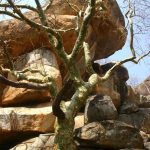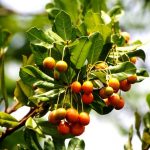TREE LIFE
February 1985
MASHONALAND CALENDAR
Tuesday February 5th : Botanic Garden Walk. Meet in the Car Park at 1645 for 1700 hours for an interesting and refreshing evening walk around the Gardens led by the very knowledgeable and dare I say, entertaining Director Tom Muller.
Sunday February 17th : A trip to Edne Ann and Aubrey Logan’s farm “Golden Star” near Shamva. Dick Petheram who is Edne Ann’s father has very kindly arranged this trip and thought out some of the interesting spots and trees for us to inspect. This area was badly hit by drought and was one of the last to benefit from the rains and we look forward to seeing if it has recovered. On our visit some years ago we were delighted at the very different vegetation in the area, even though relatively close to Harare. A bus has been booked which will leave at 0830 from the Monomatapa Car Park, where a guard will look after cars. Fare $13
ANNUAL GENERAL MEETING, SUNDAY 17TH MARCH, 1985
Formal notice with the Agenda has been given in the last Tree Life. The problem area is under Election of Officers. I say again, your present Chairman, Vice Chairman and Treasurer will be standing down from these positions and will not be seeking re-election, though that does not necessarily apply to election to the Committee. For the past year we have not had a Secretary as such and we therefore earnestly seek nominations, or at least discreet suggestions, for persons to serve on the Committee and in these positions in particular and we ask that written nominations be received by the Chairman. This will not prevent nominations from the floor at the meeting. Please take this seriously as nothing has come in since the last Tree Life. This is your society and you must sooner or later play your part in the running of it. Otherwise we will sink.
MATABELELAND CALENDAR
Sunday February 10th : N.B. our outing is being delayed one week due to a bird count. Meet at 0830 hours at Mabukuweni, Chipping Way.
Heroes Days weekend, 1985 Low veld Gona re Zhou! This is to give advance notice that the Society has been very kindly invited by the Low veld Natural History Society in conjunction with the National Parks Department, Cathy Harris liaising, to visit this most fascinating corner of the country. Basically, a camping trip is envisaged, although we have been offered a certain amount of material and catering assistance at that end. We are in the process of costing out scheduled and chartered air trips, coach trips, private car trips etc. in relation to length of visit, journey and timetables etc. The response so far, by word of mouth, has been very promising and even if it was on air charter, say, we would have no difficulty making up any shortfall in numbers from sister societies, so you can reckon on this trip being “on” and if you are interested, please let us know and start making your plans. This invitation in fact extends to all branches, and we will have to see if, and how we can co-ordinate plans. I hope to have more positive details next issue.
BOTANIC GARDEN WALK, TUESDAY 8TH JANUARY 1985
Kim Damstra will be giving a full report on this on his return from S.A. Suffice to say we had an instructive evening looking at the VERBENACEAE and BORAGINACEAE, and thank Tom Muller for his time and patience.
OUTING TO KEAGARI FARM, ARCTURUS, SUNDAY 20TH JANUARY 1985
Our trip to Keagari Farm, Arcturus, the home of John Curtis turned out to be somewhat different to our original plan. After heavy rains the week before, the bus driver was unhappy about taking the bus down the farm road and so we had a pleasant walk down to the river which could not be crossed in a car but had an ingenious device for the transportation of people. Those who were more adventurous crossed to the opposite bank while the rest of us moved off along the fence, but were not let off lightly as parts of the hill were rather steep.
The first tree we took note of was Acacia amythethophylla which is easily distinguished from the other acacias by its leaves which are longer than any other Acacia species.
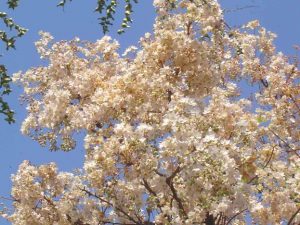
Dombeya rotundifolia, Photo: Bart Wursten. Source: Flora of Zimbabwe
Scattered around were small specimens of Dombeya rotundifolia, the wild pear. This is the tree which makes such a show with its white flowers in the spring. It is not in flower at this time of year but is identifiable by its round leaves and very characteristic pinkish tinge particularly on the new growth.
Moving on up the slope we saw Dodonaea viscosa which is one of the trees which you can recognize from its growth habit as you pass it in the car at 100 km/h – or so we are told. It is fresh green in colour and glossy. The leaves stand virtually upright making it easily recognizable and it has 3 winged fruits which are vaguely like those of Combretum. Unfortunately it was too early in the year to see fruits.
Next was Acacia karroo which is identified by the reddish bark on the new growth. A. rehmanniana has the same reddish bark but its leaflets are much smaller.
Nearby was Flacourtia indica with its pink petioles and serrated leaves. We were lucky to see such a typical example as it is a very variable species. We also saw Ficus sur , the Cape fig, with the characteristic fig bud, milk in the stems and leaves with an almost scalloped edge. As with many of the trees we saw early on in the morning, it was too small to have fruit.
Further on was Turraea nilotica a member of the Mahogany family MELIACEAE. It could be confused with Vangueria and Vangueriopsis but on close inspection, it can be seen to have alternate leaves. This particular specimen illustrated well the crumpled looking young leaves. Next was Albizia antunesiana the purple leaved albizia so called because the young plants have conspicuous purple leaves. The full grown trees can easily be confused with Burkea africana but A. antunesiana has opposite leaves and leaflets and does not have the brown velvety tips to the branches like Burkea.
At this point the trees down the slope were more and more promising so we crossed under the fence and started back in the direction of the road. Here we saw Pittosporum viridiflorum just coming into new fruit. If you crush a leaf it has a pleasant sweet smell. Growing on the slope was Xerophyta, the stems of which are sometimes cut into blocks and used as pan scourers, or are used as supports on which to grow epiphytic orchids.
We passed a very small Cussonia arborea and saw how on young specimens the leaves are not compound, just very deeply lobed. This makes for difficulties in distinguishing the young ones from other species of Cussonia.
Amongst the larger trees we saw were Ximenia caffra, the sour plum which has curving branches not unlike Strychnos and yellowy green, slightly furry leaves as opposed to the blue green, glabrous leaves of X. americana, and Pavetta gardeniifolia, easily identified by the dark spots on the leaves when held up to the light. This was one of the most spectacular trees we saw as it was in full flower, the cream coloured flowers hanging in clusters.
In the same area was Diospyros lycioides which had fruits on it showing the persistent star shaped calyx giving it the name of star apple and Erythroxylum emarginatum which had small purple fruit. When the leaves are bent over and pinched together they crack. They had a notch taken out at the top thus the specific name.
Further along we saw a tree which we thought might be a species of Zanha but it has been identified by Mr. Drummond as Ekebergia capensis. Nearby was Celtis africana, which has alternate leaves with extended tip and serrations on the leaf which go only two thirds of the way down, this distinguishes it from trema. Another distinguishing feature is the very pale grey bark.
Closer to the river were three species with long thin leaves which can be distinguished in the following ways, Rhus quartiniana has its leaves in threes, Salix subserrata has pink petioles and the leaves have a silver underside so that as the wind moves the tree it “flickers” and Myrica serrata has very serrated leaves.
We also saw Combretum molle, Psorospermum febrifugum, Ochna schweinfurthiana, Strychnos spinosa, Carissa edulis, Euclea divinorum and Euclea crispa.
The large leaved plant which we noticed on the side of the road was Inula glomerata, a yellow flowered member of the COMPOSITEAE. The shona name means hare’s ears.
We had planned to have lunch at the farm house and then look at the trees nearby but this was clearly impossible so we ate in a pleasant spot at the side of the road and went to Binga Swamp Forest, a unique forest in the middle of a vlei. As we were walking to the forest we saw more Acacia amythethophylla but this time showing typical yellow acacia flowers. Further on we saw Rhamnus prinoides which we do not often see. It has very glossy leaves and red berries. We also saw Celtis africana and Acacia sieberiana with its corky bark.
The forest is fenced and is a protected area. In the past, Mauritius thorn has been a terrible problem, threatening to take over the forest but due to the hard work of volunteers and in particular Dick Petheram, it has largely been brought under control.
On entering the forest the first thing we looked at was a Mauritius thorn seedling. At this stage they are not thorny and are easy to pull out. We then moved on to look at the trees, one of the main ones in the forest being Syzygium cordatum, the river syzygium. We also saw large specimens of Rauvolfia caffra, easily identified by the very white midrib on the leaf.
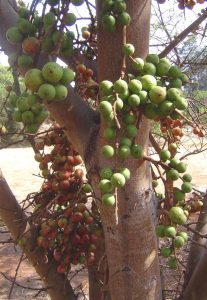
Ficus sur. Photo: Bart Wursten. Source: Flora of Zimbabwe
Having seen a small Ficus sur in the morning we were able to see a large one with the fruits on the trunk. We also saw Ekebergia capensis again. One of the ways of recognizing it is by the asymmetric base of the leaflets. It is not a very common tree.
One species which we saw in the middle of the forest and usually expect to see on the riverine fringe was Bequaertiodendron magalismontanum. Also present was Ilex mitis. It has pale and dark leaves and purple petioles which are grooved. It is in the same genus as the European holly, Ilex aquifolium. If there is any doubt about its identity a good test is to rub a leaf in your wet hands and it will lather like soap.
Having explored the forest we walked back to the bus and in spite of the change in plans all agreed that it had been a highly successful day.
Barbara Browning
FOOT NOTE : In P.B. Tomlinson’s Anatomy of the Monocotyledon II : Palmas” 1961, he states “In palms which are dioecious, eg Borassus and Hyphaene, the sexes are identical in vegetative habit, although in Borassus the two sexes can often be recognized at a distance because old leaves are more persistent on male than on female plants”. It would be interesting to note if this difference also applies to our indigenous Borassus.
-Kim Damstra.
MATABELELAND NOTES
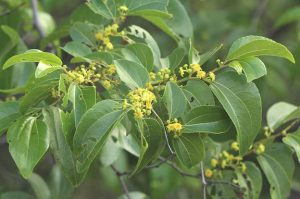
Ziziphus mucronata. Photo: Bart Wursten. Source; Flora of Zimbabwe.
On Sunday January 6th we met at the Blakes’ house in Glenville. Weather permitted, and we saw a good variety of trees and some shrubby ones in the Decomposed Granite, Acacia karroo, Acacia rehmanniana, Albizia amara, Azanza garckeana, growing alongside Dombeya rotundifolia, which always helps, Bauhinia thonningii, flowering already, a big Bolusanthus speciosus and some very eaten young ones, which confused a little. Bridelia mollis, leaves tending to be rather small, owing no doubt to poor food in the decomposed, and to drought earlier. Carissa edulis, fruiting, Cassine transvaalensis, Clerodendrum glabrum, and C. myricoides, Colophospermum mopane, Combretum apiculatum, Combretum hereroense, in both hairy and hairless variations, Combretum imberbe and C. molle, Commiphora mollis, fruiting and Commiphora mossambicensis, mainly very small, Commiphora schimperi and a very shrubby Commiphora in fruit, which puzzled us a lot. We eventually decided that it was C. pyracanthoides, probably, but it is hoped to get confirmation from the Herbarium. Also Dichrostachys cinerea, Diospyros lycioides, Diploryhnchus condylocarpon, Erythrina latissima, Euclea divinorum, Ficus glumosa, Gardenia volkensii, formerly spatulifolia, Grewia flavescens and Grewia monticola, Kirkia acuminata, Lannea discolor, Maytenus heterophylla and Maytenus senegalensis, Ormocarpum trichocarpum, Pavetta schumanniana, Pouzolzia hypoleuca, Rhus lancea, Rhus leptodictya and Rhus pyroides, Sclerocarya birrea, Securinega virosa in flower and fruit, Strychnos spinosa, Turraea nilotica, Vangueria infausta, not fruiting but other fruiting specimens in the neighbourhood seem to confirm the identity and Ziziphus mucronata.
Our thanks to the Blakes for an excellent day. We also must thank Meg Coates Palgrave for her help, in the last “Tree Life” with Terminalia sericea and Terminalia trichopoda. However, both these two seen here seemto have leaves up to 2 cm longer in each case. Hopefully this is not an indication of hybridization, and hybrid vigour!
-C. Sykes
REPORT ON THE EUROPEAN ENVIRONMENTAL BUREAU (EEB) CONFERENCE ON DEFORESTATION IN DEVELOPING COUNTRIES HELD IN CENTRE A BORSCHETTE, BRUSSELS, BELGIUM ON JUNE 7TH 8TH 1984.
Early in May the Tree Society of Zimbabwe was invited to attend the above EEB Conference and so barely a month later, I was in Brussels surrounded by a foreign language and in a hotel crowded with delegates from all over the world. One of the Conference organizers, Paloma Agrasot, will be sending us a detailed transcript of the Conference proceedings so this is just an informal report to present to members some of the spirit of the meeting.
The Conference room was an enormous hall lined with glass tanks which contained head phoned linguists silently opening and closing their mouths and looking for all the world like fish in their water tight aquaria. These translators were so efficient one could follow the current speaker’s gestures even when certain members spoke with the speed of summer lightning. All the seats were equipped with press button microphones and headphones. Behind the main table, a floor to ceiling wall of glass looked out onto a canal lined with tall trees. The room had all the modern comforts in a forest setting.
The Tree Society of Zimbabwe as a non Governmental organization in a third world country, was invited to speak for fifteen minutes on deforestation and the problems in Zimbabwe. The EEB had been informed of our activities by the ELC (Environmental Liaison Centre) of Nairobi. The objectives of the Conference were somewhat unclear to us, although it appeared that the EEB was keen for various bodies in Europe to hear and hopefully understand the problems which faced third world countries in order to plan their own projects in a more realistic manner. The Conference was funded by the French Government and the Commission of the European Communities. With the extensive press coverage one must hesitantly acknowledge that the elections for the European Parliament were but a week or so away and currently ecology is a pressing political issue throughout Europe. For us as a Society it meant we made ourselves known to other bodies and met useful contacts for further projects of our own.
The opening speech was delivered by Mlle Bouchredeau, the French Minister of State for Environment, and acting President of the Environment Council of the European Communities. She emphasized the problems of aid to third world countries and the large drain of finance within bureaucratic organizations such that the actual aid seldom reaches its final goal, or by the time it does get there, there is very little left. Instead of such aid, she emphasized the benefits of “micro projects” where small quantities of money were provided for smaller, in the field, projects, handled by non-Governmental Organizations (NGOs) within the country.
The reports from various NGOs were divided into three countries. Firstly the Asian contingent represented by Dr. Ariyaratne, President of Lanka Jatika Sarvodaya Shramadam Sagamaya, Sri Lanka; Dr. Penson, National Greening Movement, the Philippines; Ben Soans, Millions of Trees Club, India. Secondly the Central Americas represented by Yolanda Kakabadse, Fundacion Natura Ecuador; A. Bonilla, Ascona, Costa Rica, and thirdly the African continent, represented by Jacques Bugnicourt, ENDA, Senegal, Wagari Maathai ELC, Kenya and myself.
I can only describe the reports from the various NGOs as an orchestrated, yet unrehearsed concerto in three movements. The Asians spoke rapidly, excitedly telling of the vast amount of good work which they were doing in planting numerous trees all over the continent. The figures are indeed most impressive and the eastern religious fervor bubbled over. The demand was for more money to further more work. The discussion centered on exotic trees exclusively, and the plea was for encouraging forestry as an agricultural crop.
The tone changed dramatically with the Central American speakers. The quieter yet emotive appeal was for greater recognition of the threat to indigenous forests. The sincere sense of loss was expressed for an ecosystem which was being exchanged for hard cash. In some cases areas were being deforested so that a forest of fast growing exotics could be planted. It was also shown that for all the funds poured into reforestation of a small area, an area of indigenous forest could have been bought and managed as a reserve. The Conference was asked to re-establish their priorities, a forest or any forest and at what cost?
The third movement picked up the themes of the Central American speakers and consolidated their thoughts. It seems strange here in Africa to realize that Europe has such little experience of indigenous woodland or forest. Here we hardly take a second glance at an exotic and see gums and pines as very necessary, but yet as scars on the African landscape, which are there to help reduce the pressure on indigenous woodland. In contrast Europe thrives within an exotic garden and hardly notices. The European countryside is an exhilarating experience, but one must recognize that many of their forests are planted and that the trees have been cultivated for many years. We, on the other hand, may wander for miles through indigenous woodland, trees which have never been “cared for” by man. This difference underlies much of European thinking which we and they need to recognize if anyone is going to understand the problem. We may succeed in growing a woodland simply by allowing regeneration. The European solution is to actively plant a forest. In Africa planting is an essential undertaking as a protective measure, designed to provide for human necessities in order to prevent the destruction of our indigenous woodland. This woodland is varied and thus provides a wide range of produce, from specialized woods and medicines to fruit, seeds and even caterpillars for food. This was the message from Africa.
Jacques Bugnicourt, Senegal, told the story of a forest tribe who had been progressively restricted as the forest was removed for timber. Their answer to being re-sited in an afforested area was simple: ‘One tree is not a forest’. By means of some excellent photographs (provided by Meg Coates Palgrave), I was able to show the conference Zimbabwean woodland and its varied uses, as well as the pressures which are put on the woodland, both by humans and animals. Dr. Cumming of National Parks and Wildlife Management lent me a slide of an aerial photograph showing a woodland totally destroyed by elephant on one side of the tsetse control fence which was erected a mere ten years earlier. This emphasizes the importance of culling the enormous numbers of elephant, a point seldom appreciated by the emotional anti-hunting movements abroad. I also showed some of the recent conservation work which the Tree Society had done and emphasized the present Zimbabwean Government’s sincere interest in reforestation as a means of development.
The rest of the Conference discussed the economic and political aspects of deforestation and the roles of NGO’s, particularly those in Europe. For us here in Zimbabwe, we may be able to get financial backing for a relevant project by means of sending written proposals to the ELC in Nairobi, as they are in contact with many funding bodies and have helped us in the past, the Mukuvisi woodlot was funded through them. Secondly we may approach the United Nations through Jill Carr Harris, NGO Liaison Office, United Nations.
Right at the moment there is a large financial input into Zimbabwe on feasibility studies and professional advice. These surveys are currently being run with huge budgets that cannot be compared with our turnover even for a decade. They also have much Governmental support, particularly in the rural area. These projects are presently in their infancy and so I hesitate to draw attention to the words of Mlle Bouchardeau, but with this professional input, I personally see the role of the Tree Society at present as a more educational one, getting people interested in knowing our trees. Knowledge leads to a greater appreciation and hopefully to greater conservation awareness.
-Kim Damstra
P.S. From Brussels I made my way to a sunny Britain where the May flowers, Hawthorn and Chestnuts of Primrose Hill were in full blossom and the lush Welsh oak forests were a purple mass of rhododendrons. I was met in Plymouth by Mr. Dennis Hull, Chairman of the Men of the Trees, a word wide body dedicated to the planting of trees. From Plymouth we crossed the expanse of Dartmoor and drove between the tall “Devonhedge’ which hugs the winding country roads. Mr. Hull is a tree enthusiast par excellence, not only does he enjoy walking through the forests, but he practices what he preaches and personally wields a shovel. He is also editor of their journal which is a stirring publication spreading the message of tree planting. Together we wandered through a number of forests and plantations where I was introduced to the trees which are culturally ingrained within our experience although we seldom see them here in Africa. I was surprised to learn that the larch is a deciduous conifer, and it was refreshing to pass through mixed woodland plantations containing the Californian redwood. Despite the talk about a local Devon drought the countryside was the lush green which we only associate with the height of the rainy season. In the evening I showed a collection of Meg’s slides to an eager band of the society’s members. It was indeed a rewarding experience and we hope that one day Mr. Hull and his wife will be able to visit the Zimbabwe woodland.


